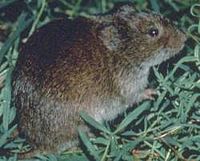
The effect of monoamines reuptake inhibitors on aerobic exercise performance in bank voles from a selection experiment
Sign Up to like & getrecommendations! Published in 2019 at "Current Zoology"
DOI: 10.1093/cz/zoy063
Abstract: Abstract Exercise performance depends on both physiological abilities (e.g., muscle strength) and behavioral characteristics (e.g., motivation). We tested the hypothesis that evolution of increased aerobic exercise performance can be facilitated by evolution of neuropsychological mechanisms… read more here.
Keywords: bank voles; reuptake inhibitors; exercise performance; exercise ... See more keywords

Zoonotic Virus Seroprevalence among Bank Voles, Poland, 2002–2010
Sign Up to like & getrecommendations! Published in 2019 at "Emerging Infectious Diseases"
DOI: 10.3201/eid2508.190217
Abstract: Bank voles in Poland are reservoirs of zoonotic viruses. To determine seroprevalence of hantavirus, arenavirus, and cowpox virus and factors affecting seroprevalence, we screened for antibodies against these viruses over 9 years. Cowpox virus was… read more here.
Keywords: bank voles; seroprevalence; voles poland; virus ... See more keywords

Influence of Season, Population and Individual Characteristics on the Prevalence of Leptospira spp. in Bank Voles in North-West Germany
Sign Up to like & getrecommendations! Published in 2021 at "Biology"
DOI: 10.3390/biology10090933
Abstract: Simple Summary Leptospirosis is a worldwide emerging zoonotic disease. Clinical symptoms in humans range from mild flu-like symptoms to severe clinical disease with kidney failure and multiple organ dysfunction. Infections occur after contact with infected… read more here.
Keywords: leptospira spp; bank voles; prevalence; bank ... See more keywords

No Evidence for the Presence of SARS-CoV-2 in Bank Voles and Other Rodents in Germany, 2020–2022
Sign Up to like & getrecommendations! Published in 2022 at "Pathogens"
DOI: 10.3390/pathogens11101112
Abstract: Rodentia is the most speciose mammalian order, found across the globe, with some species occurring in close proximity to humans. Furthermore, rodents are known hosts for a variety of zoonotic pathogens. Among other animal species,… read more here.
Keywords: evidence presence; 2020 2022; bank voles; presence sars ... See more keywords

Tropism of Puumala orthohantavirus and Endoparasite Coinfection in the Bank Vole Reservoir
Sign Up to like & getrecommendations! Published in 2023 at "Viruses"
DOI: 10.3390/v15030612
Abstract: In Europe, most cases of human hantavirus disease are caused by Puumala orthohantavirus (PUUV) transmitted by bank voles (Clethrionomys glareolus, syn. Myodes glareolus), in which PUUV causes inconspicuous infection. Little is known about tropism and… read more here.
Keywords: tropism puumala; bank; puumala orthohantavirus; bank voles ... See more keywords